Top News
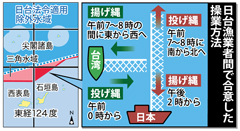
March 21, 2014 Fumitetsu Jahana of Ryukyu Shimpo
On March 20, Okinawan and Taiwanese fishermen agreed on operation in part of the triangular area of the waters north of the Yaeyama Islands. The meeting was held under the fisheries agreement between Japan and Taiwan. The fishermen of Japan and Taiwan have agreed to operate for 24 hours a day by adjusting the hours of casting and drawing their lines. It is the first time that they have agreed on the methods of the operation in a concrete way. They confirmed this agreement at the fourth meeting between the fishermen of Japan and Taiwan held in Taiwan on March 10. A member of the meeting reported to the Okinawa Prefecture Fishery Operators Association on the issues of the fisheries disputes between China, Taiwan, and Japan on March 20.
Japan and Taiwan agreed at the third meeting of a Taiwan-Japan fishing commission that Japanese fishermen would operate maintaining a four-nautical-mile distance between boats in the designated area with five-days prior notification. However, at the fourth meeting between the fishermen of Japan and Taiwan, they introduced new methods for being able to operate every day. In fact, they can operate every day with or without prior notification. Taiwanese fishing boats’ operation will be reduced from two to one a day. Japanese fishing boats set their lines in a south to north direction to 25 degrees 10 minutes north latitude during the time from 7:00 a.m. to 8:00 a.m., and they will draw their lines at 2:00 p.m. Taiwanese fishing boats set their lines from west to east direction to 124 degrees 15 minutes east longitude at 12:00 a.m., and they will draw their lines during the time from 7:00 a.m. to 8:00 a.m.
Using this method, Japanese fishing boats are able to set their lines in the designated area while Taiwanese boats draw their lines. The fishermen from both sides can operate equally in overlapping waters without trouble.
The fishermen of Japan and Taiwan will practice this method from April 20, the opening day of the fishing season in Taiwan, to July when the fishing season of bluefin tuna ends. The next year’s operation will be discussed at the fifth meeting between fishermen of Japan and Taiwan after the fishing season ends. Both sides confirmed that the Yaeyama Fishing Cooperative, the Okinawa Fishery Radio Association, the Suao Fishery Association and the Suao Fishery Radio Association will provide a link for information between Japan and Taiwan.
(English translation by T&CT)
Go to Japanese
March 13, 2014 Ryukyu Shimpo
On March 12, the Japan Federation of Bar Associations held a press conference in Tokyo. The association released a statement about the Japan-U.S. Status-of-Forces Agreement (SOFA). It is the first time the association has released a statement about revising the agreement. In the statement, they indicated their opposition to the landfill construction of Henoko in Nago to build a new base to replace U.S. Marine Corps Futenma Air Station. They stated, “We will not allow it.” The association called for environmental rules and for the handing over of suspected criminals for indictment.
The statement demanded that the U.S. and Japanese governments revise the following subjects: (1) providing and returning the facilities and areas; (2) application of Japanese laws and rules; (3) environmental protection; (4) vessels and aircraft operated by, for, or under the control of the United States; (5) air traffic; (6) criminal responsibility; (7) civil liability.
The association is seeking to set up rules for environmental protection and to define the obligation of U.S. forces to restore land to its original state when pollution occurs on a base. Referring to moving Futenma Air Station to Henoko, they pointed out that landfilling in Oura Bay in Henoko which has much biodiversity “is nothing but an act against god and is unforgivable.”
They demand that both governments should allow Japan to arrest suspects in the U.S. military and civilian personnel in criminal cases before indictments. In addition, they claimed the suspects should be regarded as being off-duty when evidence is inadequate to suggest they are on-duty.
They also demand the Japanese government should provide full compensation for damages in civil cases committed by off-duty U.S. personnel.
Tsutomu Arakaki is a member of a special research group for U.S. military base issues in the Human Rights Committee of the association and has detailed knowledge of the agreement. He said, “It is important that the largest group of law professionals clarifies legal opinions on the agreement. It would have a significant impact on negotiations between Japan and the United States.”
(English translation by T&CT and Lima Tokumori)
Go to Japanese
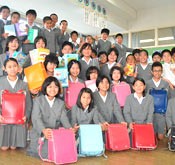
March 19, 2014 Ryukyu Shimpo
Thirteen nine pupils of the sixth-year grade of Kadena Elementary School will send ten satchels that they have used for six years, and writing materials to children in Afghanistan. The pupils are graduating from the elementary school on March 19. They want all the children in Afghanistan to be able go to school. Nao Asato and Yumeri Taira were really impressed when they read a picture book in which the children in Afghanistan received the donated school bags gratefully. In late January, they called for classmates to send satchels. There are many children who are not given the opportunity to have education, because of years of continuing conflict in Afghanistan.
Yumeri said, “I was surprised to hear there some children use satchels instead desks. We want them to carefully use the things that we are sending.”
Yusuke Nakasone, who packed notebooks into a bag, said, “I want Afghanistan to become a peaceful country without war. Sakumoto, the home room teacher of the class, said, “I am glad that the children have their ability to plan and to act by themselves.” She was surprised by the growth of her pupils. These items will be delivered to the children in Afghanistan by a volunteer group.
(English translation by T&CT)
Go to Japanese
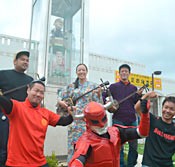
March 13, 2014 Ryukyu Shimpo
The Ishikawa Youth Association Buten-Kai held a sanshin concert at a plaza known as Buten-hiroba, in Uruma City on March 4.
Buten Onaha (1897-1969) was a dentist from Okinawa who worked as a producer and creator of comedy during the reconstruction period after the Battle of Okinawa.
It is the first time that Buten-Kai has held an event on Sanshin Day. Masamune Itokazu, director of the group, said, “We would like to expand the spirit of harmony in the community and to continue the event every year.”
Taishi Iha, the vice-director of the group and a bullfight announcer, called for passers-by to take part in the event, bringing with their sanshins. The event opened at noon with the Ryukyu classical sanshin performance Kagiyade-Fu by Shoko Kuratomi, Takeichi Teruya and Satoshi Miyara. Many people, including shoppers, stopped and enjoyed the sanshin music and singing.
“I want my grandchild who is going to learn sanshin to watch this,” said Mieko Tamashiro. “I want to bring my mother here,” said Naomi Suzuki. Harue Iha, a woman working at a shop near the plaza, said, “I am happy to see young people use this space for their activities.”
Director Itokazu said, “We welcome anybody who can dance or play drums. We want men and women of all ages to take part in the event on Sanshin Day.”
(English translation by T&TC, Hitomi Shinzato)
Go to Japanese
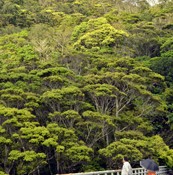
March 16, 2014 Ryukyu Shimpo
New green leaves have grown from the buds in the northern part of Okinawa, marking the beginning of spring.
On March 16, a clear day, people visited Nagao bridge on Okuni forest road in Kunigani Village to view the new green leaves.
On warm days in Spring, yellow buds between branches of Castanopsis sieboldii glow while swaying in the wind.
People can enjoy new green leaves until the end of March.
Tomonobu Shimabukuro, who came from Sasiki district of Nanjo City with his wife, said, “I visit Yanbaru or the forested northern part of Okinawa every year to see the new green leaves. Listening to the birds singing with the great scenery is refreshing.”
(English translation by T&CT)
Go to Japanese

March 17, 2014 Ryukyu Shimpo
The third Sugar Ride Kumejima started at Ojima on March 16. Cyclists enjoyed touring around Kumejima Town, which has rich nature.
Over the 130 kilometer-Challenge course, the participants did three laps of the island. In the 90 kilometer-Athlete course, they did two laps. In the 45 kilometer-Tourist course, the cyclists went around the island once. The event had 214 participants, with 196 people completing the courses. Under the clear sky, the participants cycled around the island at their own pace. People standing along the road cheered them.
The cycling event began in 2012 to promote the charm of the island through the bicycle ride.
The courses included Teada bridge and Tsumugi bridge, which span a new road that has been open to traffic since last November. The participants enjoyed a glorious view of Kerama Islands.
Oita prefecture resident Kika Kuno who took part in the event with 11 fellow cyclists, said, “After biking up the steep hill, I had glorious view in front of me. I enjoyed Kumejima.”
(English translation by T&CT)
Go to Japanese
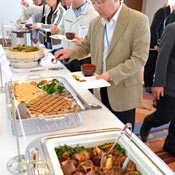
March 14, 2014 Ryukyu Shimpo
At the Southern Beach Hotel and Resort in Itoman City on March 10, the Okinawa Prefectural Government held a sampling party of goat meat dishes to expand the market of locally grown goat meat. The government asked four chefs of the hotel to create 14 Japanese, Western, and Chinese dishes. About 50 guests from distribution and tourism industries tasted them. They gave positive feedback; “The dishes were delicious without the particular smell that goat has.”
It is a part of the government’s project to create an Okinawan goat brand.
Two Okinawan Goats that are hybrid brand of an indigenous goat (Capra aegagrus hircus) and Boer goat from New Zealand, were used in the dishes. The chefs served unique goat dishes that differ from traditional ones, such as Goat Shabu Shabu, Goat Herbal Soup and Goat Carpaccio, for young adults and tourists.
Hirokazu Taira, who works at the Product Management Division of Kyoei Meat, said, “I hesitated to eat goat meat at first, but it tastes good. If there are any interesting ideas for using goat meat, we would like to consider commercializing them.” Chojin Yara from Marine Leisure business was excited about the goat brand. He remarked, “We proudly recommend them to the people of the mainland of Japan. We can use them for beach barbecues.”
(English translation by T&CT and Megumi Chibana)
Go to Japanese

March 16, 2014 Ryukyu Shimpo
On March 15, at the Central Park Avenue in Okinawa City, local residents celebrated St. Patrick’s Day, the largest event in Ireland. About 120 people, wearing Ireland’s national color green costumes, marched on the street to Irish music played by a band. St. Patrick’s Day commemorates death of the Irish patron saint who is known for spreading Christianity throughout Ireland. Many people from various groups took part in the parade, which was sponsored by the Okinawa City Center Shopping District Promotion Association.
(English translation by T&CT)
Go to Japanese
March 14, 2014 Ryukyu Shimpo
At the Upper House Foreign Affairs Defense Committee meeting on March 13, Defense Minister Itsunori Onodera stated that the total cost of moving U.S. Marine Corps Futenma Air Station to Henoko, Nago, would be at least 350 billion yen. It is the first time that the government has commented on the total estimated cost for the project since Japan and the United States agreed in 2006 that they would build V-shaped runway in Henoko.
In addition to the 231.1 billion yen for the reclamation cost, the defense minister explained that it would cost additional budget for such as environment protection, developing the airport facilities and upgrading the land portion of Camp Schwab. In the application that they submitted to the Okinawa Prefectural Government the Okinawa Defense Bureau estimated the landfill construction cost at 231 billion and 87 million yen.
With respect to Okinawa Governor Hirokazu Nakaima’s request to stop the operation of the Futenma base within five years, Onodera declined to comment. Referring to a new special agreement on environmental protection that will supplement the Japan-U.S. Status of Forces Agreement (SOFA), Foreign Minister Fumio Kishida said, “The agreement will not include the noise issue generated by aircraft flying out the U.S. base.” He suggested that Japan and the United States would not negotiate on the noise problem. Foreign Minister and Defense Minister were answering questions from Yukihisa Fujita (Democratic Party) and Satoshi Inoue (Communist Party).
(English translation by T&CT)
Go to Japanese
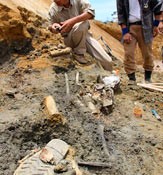
March 13, 2014 Ryuyu Shimpo
The Ministry of Health, Labor and Welfare has carried out DNA analysis on the human remains that were found in Maeda district of Urasoe last July. The ministry identified the remains and found the bereaved family on March 12. The human remains belong to a Japanese Imperial Army soldier in the Battle of Okinawa.
This is the third case involving analysis to identify human remains from the Battle of Okinawa. In the two previous cases, the analysis revealed the identities of human remains of two Japanese soldiers found in November 2009 and March 2010 in Makabi district of Naha.
The researchers found the most recent set of human remains wearing rubber-soled socks, and with its face down. They also unearthed a personal seal engraved with the name “Tabata” around it. After receiving the teeth of the remains from the Okinawa Prefectural Government last August, the ministry carried out DNA analysis.
Tokyo resident Kazuo Tabata who is from Karafuto or Sakhalin Island, claimed the remains belonged to his father. However, the ministry has not released the identity of the remains because of the Private Information Protection Law. The ministry plans to reveal the results of the analysis to the bereaved family through the government of the prefecture where the remains belong. The ministry then decides whether to announce the result.
(English translation by T&CT)
Go to Japanese
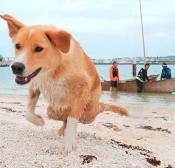
March 14, 2014 Masaaki Umeda of Ryukyu Shimpo
A popular one-year-old male dog named Saburo energetically plays around the coast in Itoman, running in the sea spray to the amusement of locals at Fisher Craft Center. A hit-and-run accident left him a paraplegic last summer. He lost his rear left leg. However since then, Saburo has miraculously recovered from the injuries thanks to the dedicated care of the members of the center. He can now walk with three legs.
Saburo was once an abandoned dog. But in March 2013, a sixty-four-year-old sabani fishing boat-builder Kiyoshi Oshiro, who belongs to the non-profit organization Beach Lovers and manages the center, started to take care of him. Saburo loved being on sabani with Oshiro and enjoyed sea.
The members of the center and visitors grew to love Saburo and he became very popular.
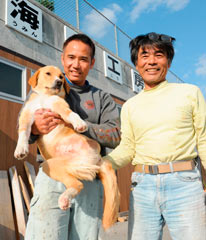
Kiyoshi Oshiro (right) and Kazuaki Takara who devotedly took care of Saburo, at Fisher Craft Center in Itoman on March 10. (Photograph taken by Masatoshi Moromizato).
When Oshiro was working at the center in August 2013, he heard a hard sound. Oshiro found Saburo crying out after being struck by a hit-and-run driver.
Saburo had his back-bone broken. A veterinarian told Oshiro there was no chance that he could recover from injuries in the lower body.
Despite the option of comfortable death, Oshiro managed to pay for surgical fees by selling his sabani to save Saburo’s life. Although Saburo escaped death, he was left paraplegic.
After the accident, Saburo could not even walk. However, Kazuaki Takara who belongs to the center, and his wife Tomoko brought Saburo to the beach to take a walk for rehabilitation in the early morning and afternoon.
With a harness on his waist, Saburo continued to move his lower body slowly for rehabilitation. His rear right leg started moving. Tomoko said, “When I saw his leg moving, I was so glad that I forgot all the hardships.”
Saburo had his rear left leg cut off this February because it became necrotic. However, he recovered from the injuries so well that he can now run on the sand beach and swim because of the continuous rehabilitation.
Sabani enthusiasts in Okinawa who were worried about Saburo, collected donations.
Takara and Oshiro are overjoyed by Saburo’s recovery. Takara said, “I love seeing Saburo’s face every day. I am looking forward to seeing him on the sabani with me.” Oshiro said, “I am really glad that everyone takes care of Saburo. He has good friends.” Oshiro said, “I am really glad that Saburao recovered.”
(English translation by T&CT)
Go to Japanese










 Webcam(Kokusai Street)
Webcam(Kokusai Street)


